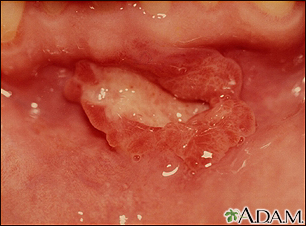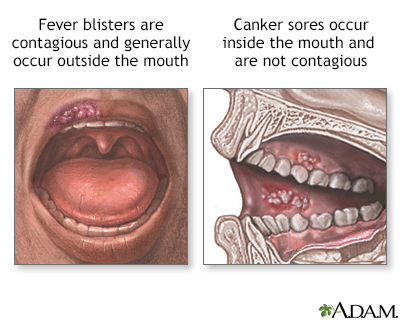Pregnancy SmartSiteTM
Aphthous ulcer; Ulcer - aphthous DefinitionA canker sore is a painful, open sore in the mouth. Canker sores are white or yellow and surrounded by a bright red area. They are not cancerous. A canker sore is not the same as a fever blister (cold sore). CausesCanker sores are a common form of mouth ulcer. They may occur with viral infections. In some cases, the cause is unknown. Canker sores may also be linked to problems with the body's immune system. The sores may also be brought on by:
Other things that can trigger canker sores include:
Anyone can develop a canker sore. Women are more likely to get them than men. Canker sores may run in families. SymptomsCanker sores most often appear on the inner surface of the cheeks and lips, tongue, upper surface of the mouth, and the base of the gums. Symptoms include:
Less common symptoms include:
Pain often goes away in 7 to 10 days. It can take 1 to 3 weeks for a canker sore to completely heal. Large ulcers can take longer to heal. Exams and TestsYour health care provider can often make the diagnosis by looking at the sore. If canker sores persist or continue to return, tests should be done to look for other causes, such as erythema multiforme, drug allergies, herpes infection, and bullous lichen planus. You may need further testing or a biopsy to look for other causes of mouth ulcers. Canker sores are not cancer and do not cause cancer. There are types of cancer, however, that may first appear as a mouth ulcer that does not heal. TreatmentIn most cases, the canker sores go away without treatment. Try not to eat hot or spicy foods, which can cause pain. Use over-the-counter medicines that ease pain in the area.
Medicines prescribed by your provider may be needed for severe cases. These may include:
Brush your teeth twice a day and floss your teeth every day. Also, get routine dental check-ups. In some cases, gastric acid-reducing medicines can decrease the discomfort. Outlook (Prognosis)Canker sores almost always heal on their own. The pain should decrease in a few days. Other symptoms disappear in 10 to 14 days. When to Contact a Medical ProfessionalContact your provider if:
ReferencesDaniels TE, Jordan RC. Diseases of the mouth and salivary glands. In: Goldman L, Schafer AI, eds. Goldman-Cecil Medicine. 26th ed. Philadelphia, PA: Elsevier; 2020:chap 397. Dhar V. Common lesions of the oral soft tissues. In: Kliegman RM, St. Geme JW, Blum NJ, Shah SS, Tasker RC, Wilson KM, eds. Nelson Textbook of Pediatrics. 21st ed. Philadelphia, PA: Elsevier; 2020:chap 341. Klatt EC. Head and neck. In: Klatt EC, ed. Robbins and Cotran Atlas of Pathology. 4th ed. Philadelphia, PA: Elsevier; 2021:chap 6. | |
| |
Review Date: 6/4/2023 Reviewed By: Josef Shargorodsky, MD, MPH, Johns Hopkins University School of Medicine, Baltimore, MD. Also reviewed by David C. Dugdale, MD, Medical Director, Brenda Conaway, Editorial Director, and the A.D.A.M. Editorial team. The information provided herein should not be used during any medical emergency or for the diagnosis or treatment of any medical condition. A licensed medical professional should be consulted for diagnosis and treatment of any and all medical conditions. Links to other sites are provided for information only -- they do not constitute endorsements of those other sites. No warranty of any kind, either expressed or implied, is made as to the accuracy, reliability, timeliness, or correctness of any translations made by a third-party service of the information provided herein into any other language. © 1997- A.D.A.M., a business unit of Ebix, Inc. Any duplication or distribution of the information contained herein is strictly prohibited. | |

 Canker sore
Canker sore Mouth anatomy
Mouth anatomy Canker sore (aphth...
Canker sore (aphth... Fever blister
Fever blister
